-
 Lookout #40 1/2
Lookout #40 1/2 Lookout magazine started as a xeroxed community newsletter when Lawrence Livermore lived on Spy Rock, just a few miles north of Layonville, CA. Spy Rock was part of a constellation of locales across Mendocino and Humbdolt County that, since the late 1960s, had become increasingly popular among artists, hippies, and back-to-the-landers. Initially crafted in his solar-powered home, not far from the Iron Peak Lookout Tower, from which the magazine takes its name, the magazine engaged with local politics and tackled issues as diverse as environmental issues and countercultural philosophy. Over the years, following Livermore’s involvement with the Gilman Street Project in Berkeley and the punk-rock scene that loomed around it, Lookout’s focus shifted to music, which resulted in finding a whole new audience in the Bay Area and across the United States, especially among Maximum Rocknroll readers.
-
 Lookout #40
Lookout #40 Lookout magazine started as a xeroxed community newsletter when Lawrence Livermore lived on Spy Rock, just a few miles north of Layonville, CA. Spy Rock was part of a constellation of locales across Mendocino and Humbdolt County that, since the late 1960s, had become increasingly popular among artists, hippies, and back-to-the-landers. Initially crafted in his solar-powered home, not far from the Iron Peak Lookout Tower, from which the magazine takes its name, the magazine engaged with local politics and tackled issues as diverse as environmental issues and countercultural philosophy. Over the years, following Livermore’s involvement with the Gilman Street Project in Berkeley and the punk-rock scene that loomed around it, Lookout’s focus shifted to music, which resulted in finding a whole new audience in the Bay Area and across the United States, especially among Maximum Rocknroll readers.
-
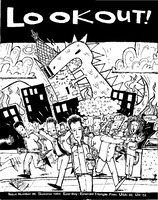 Lookout #39
Lookout #39 Lookout magazine started as a xeroxed community newsletter when Lawrence Livermore lived on Spy Rock, just a few miles north of Layonville, CA. Spy Rock was part of a constellation of locales across Mendocino and Humbdolt County that, since the late 1960s, had become increasingly popular among artists, hippies, and back-to-the-landers. Initially crafted in his solar-powered home, not far from the Iron Peak Lookout Tower, from which the magazine takes its name, the magazine engaged with local politics and tackled issues as diverse as environmental issues and countercultural philosophy. Over the years, following Livermore’s involvement with the Gilman Street Project in Berkeley and the punk-rock scene that loomed around it, Lookout’s focus shifted to music, which resulted in finding a whole new audience in the Bay Area and across the United States, especially among Maximum Rocknroll readers.
-
 Lookout #38
Lookout #38 Lookout magazine started as a xeroxed community newsletter when Lawrence Livermore lived on Spy Rock, just a few miles north of Layonville, CA. Spy Rock was part of a constellation of locales across Mendocino and Humbdolt County that, since the late 1960s, had become increasingly popular among artists, hippies, and back-to-the-landers. Initially crafted in his solar-powered home, not far from the Iron Peak Lookout Tower, from which the magazine takes its name, the magazine engaged with local politics and tackled issues as diverse as environmental issues and countercultural philosophy. Over the years, following Livermore’s involvement with the Gilman Street Project in Berkeley and the punk-rock scene that loomed around it, Lookout’s focus shifted to music, which resulted in finding a whole new audience in the Bay Area and across the United States, especially among Maximum Rocknroll readers.
-
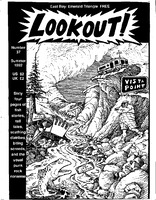 Lookout #37
Lookout #37 Lookout magazine started as a xeroxed community newsletter when Lawrence Livermore lived on Spy Rock, just a few miles north of Layonville, CA. Spy Rock was part of a constellation of locales across Mendocino and Humbdolt County that, since the late 1960s, had become increasingly popular among artists, hippies, and back-to-the-landers. Initially crafted in his solar-powered home, not far from the Iron Peak Lookout Tower, from which the magazine takes its name, the magazine engaged with local politics and tackled issues as diverse as environmental issues and countercultural philosophy. Over the years, following Livermore’s involvement with the Gilman Street Project in Berkeley and the punk-rock scene that loomed around it, Lookout’s focus shifted to music, which resulted in finding a whole new audience in the Bay Area and across the United States, especially among Maximum Rocknroll readers.
-
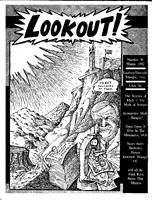 Lookout #36
Lookout #36 Lookout magazine started as a xeroxed community newsletter when Lawrence Livermore lived on Spy Rock, just a few miles north of Layonville, CA. Spy Rock was part of a constellation of locales across Mendocino and Humbdolt County that, since the late 1960s, had become increasingly popular among artists, hippies, and back-to-the-landers. Initially crafted in his solar-powered home, not far from the Iron Peak Lookout Tower, from which the magazine takes its name, the magazine engaged with local politics and tackled issues as diverse as environmental issues and countercultural philosophy. Over the years, following Livermore’s involvement with the Gilman Street Project in Berkeley and the punk-rock scene that loomed around it, Lookout’s focus shifted to music, which resulted in finding a whole new audience in the Bay Area and across the United States, especially among Maximum Rocknroll readers.
-
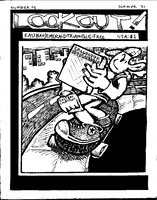 Lookout #35
Lookout #35 Lookout magazine started as a xeroxed community newsletter when Lawrence Livermore lived on Spy Rock, just a few miles north of Layonville, CA. Spy Rock was part of a constellation of locales across Mendocino and Humbdolt County that, since the late 1960s, had become increasingly popular among artists, hippies, and back-to-the-landers. Initially crafted in his solar-powered home, not far from the Iron Peak Lookout Tower, from which the magazine takes its name, the magazine engaged with local politics and tackled issues as diverse as environmental issues and countercultural philosophy. Over the years, following Livermore’s involvement with the Gilman Street Project in Berkeley and the punk-rock scene that loomed around it, Lookout’s focus shifted to music, which resulted in finding a whole new audience in the Bay Area and across the United States, especially among Maximum Rocknroll readers.
-
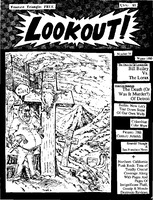 Lookout #34
Lookout #34 Lookout magazine started as a xeroxed community newsletter when Lawrence Livermore lived on Spy Rock, just a few miles north of Layonville, CA. Spy Rock was part of a constellation of locales across Mendocino and Humbdolt County that, since the late 1960s, had become increasingly popular among artists, hippies, and back-to-the-landers. Initially crafted in his solar-powered home, not far from the Iron Peak Lookout Tower, from which the magazine takes its name, the magazine engaged with local politics and tackled issues as diverse as environmental issues and countercultural philosophy. Over the years, following Livermore’s involvement with the Gilman Street Project in Berkeley and the punk-rock scene that loomed around it, Lookout’s focus shifted to music, which resulted in finding a whole new audience in the Bay Area and across the United States, especially among Maximum Rocknroll readers.
-
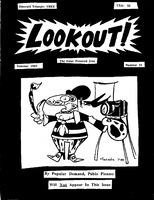 Lookout #33
Lookout #33 Lookout magazine started as a xeroxed community newsletter when Lawrence Livermore lived on Spy Rock, just a few miles north of Layonville, CA. Spy Rock was part of a constellation of locales across Mendocino and Humbdolt County that, since the late 1960s, had become increasingly popular among artists, hippies, and back-to-the-landers. Initially crafted in his solar-powered home, not far from the Iron Peak Lookout Tower, from which the magazine takes its name, the magazine engaged with local politics and tackled issues as diverse as environmental issues and countercultural philosophy. Over the years, following Livermore’s involvement with the Gilman Street Project in Berkeley and the punk-rock scene that loomed around it, Lookout’s focus shifted to music, which resulted in finding a whole new audience in the Bay Area and across the United States, especially among Maximum Rocknroll readers.
-
 Lookout #32
Lookout #32 Lookout magazine started as a xeroxed community newsletter when Lawrence Livermore lived on Spy Rock, just a few miles north of Layonville, CA. Spy Rock was part of a constellation of locales across Mendocino and Humbdolt County that, since the late 1960s, had become increasingly popular among artists, hippies, and back-to-the-landers. Initially crafted in his solar-powered home, not far from the Iron Peak Lookout Tower, from which the magazine takes its name, the magazine engaged with local politics and tackled issues as diverse as environmental issues and countercultural philosophy. Over the years, following Livermore’s involvement with the Gilman Street Project in Berkeley and the punk-rock scene that loomed around it, Lookout’s focus shifted to music, which resulted in finding a whole new audience in the Bay Area and across the United States, especially among Maximum Rocknroll readers.
-
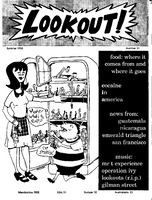 Lookout #31
Lookout #31 Lookout magazine started as a xeroxed community newsletter when Lawrence Livermore lived on Spy Rock, just a few miles north of Layonville, CA. Spy Rock was part of a constellation of locales across Mendocino and Humbdolt County that, since the late 1960s, had become increasingly popular among artists, hippies, and back-to-the-landers. Initially crafted in his solar-powered home, not far from the Iron Peak Lookout Tower, from which the magazine takes its name, the magazine engaged with local politics and tackled issues as diverse as environmental issues and countercultural philosophy. Over the years, following Livermore’s involvement with the Gilman Street Project in Berkeley and the punk-rock scene that loomed around it, Lookout’s focus shifted to music, which resulted in finding a whole new audience in the Bay Area and across the United States, especially among Maximum Rocknroll readers.
-
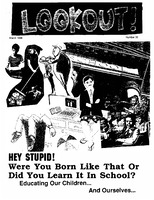 Lookout #30
Lookout #30 Lookout magazine started as a xeroxed community newsletter when Lawrence Livermore lived on Spy Rock, just a few miles north of Layonville, CA. Spy Rock was part of a constellation of locales across Mendocino and Humbdolt County that, since the late 1960s, had become increasingly popular among artists, hippies, and back-to-the-landers. Initially crafted in his solar-powered home, not far from the Iron Peak Lookout Tower, from which the magazine takes its name, the magazine engaged with local politics and tackled issues as diverse as environmental issues and countercultural philosophy. Over the years, following Livermore’s involvement with the Gilman Street Project in Berkeley and the punk-rock scene that loomed around it, Lookout’s focus shifted to music, which resulted in finding a whole new audience in the Bay Area and across the United States, especially among Maximum Rocknroll readers.
-
 Lookout #29
Lookout #29 Lookout magazine started as a xeroxed community newsletter when Lawrence Livermore lived on Spy Rock, just a few miles north of Layonville, CA. Spy Rock was part of a constellation of locales across Mendocino and Humbdolt County that, since the late 1960s, had become increasingly popular among artists, hippies, and back-to-the-landers. Initially crafted in his solar-powered home, not far from the Iron Peak Lookout Tower, from which the magazine takes its name, the magazine engaged with local politics and tackled issues as diverse as environmental issues and countercultural philosophy. Over the years, following Livermore’s involvement with the Gilman Street Project in Berkeley and the punk-rock scene that loomed around it, Lookout’s focus shifted to music, which resulted in finding a whole new audience in the Bay Area and across the United States, especially among Maximum Rocknroll readers.
-
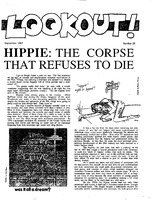 Lookout #28
Lookout #28 Lookout magazine started as a xeroxed community newsletter when Lawrence Livermore lived on Spy Rock, just a few miles north of Layonville, CA. Spy Rock was part of a constellation of locales across Mendocino and Humbdolt County that, since the late 1960s, had become increasingly popular among artists, hippies, and back-to-the-landers. Initially crafted in his solar-powered home, not far from the Iron Peak Lookout Tower, from which the magazine takes its name, the magazine engaged with local politics and tackled issues as diverse as environmental issues and countercultural philosophy. Over the years, following Livermore’s involvement with the Gilman Street Project in Berkeley and the punk-rock scene that loomed around it, Lookout’s focus shifted to music, which resulted in finding a whole new audience in the Bay Area and across the United States, especially among Maximum Rocknroll readers.
-
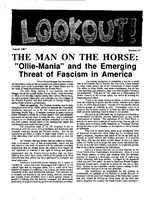 Lookout #27
Lookout #27 Lookout magazine started as a xeroxed community newsletter when Lawrence Livermore lived on Spy Rock, just a few miles north of Layonville, CA. Spy Rock was part of a constellation of locales across Mendocino and Humbdolt County that, since the late 1960s, had become increasingly popular among artists, hippies, and back-to-the-landers. Initially crafted in his solar-powered home, not far from the Iron Peak Lookout Tower, from which the magazine takes its name, the magazine engaged with local politics and tackled issues as diverse as environmental issues and countercultural philosophy. Over the years, following Livermore’s involvement with the Gilman Street Project in Berkeley and the punk-rock scene that loomed around it, Lookout’s focus shifted to music, which resulted in finding a whole new audience in the Bay Area and across the United States, especially among Maximum Rocknroll readers.
-
 Lookout #26
Lookout #26 Lookout magazine started as a xeroxed community newsletter when Lawrence Livermore lived on Spy Rock, just a few miles north of Layonville, CA. Spy Rock was part of a constellation of locales across Mendocino and Humbdolt County that, since the late 1960s, had become increasingly popular among artists, hippies, and back-to-the-landers. Initially crafted in his solar-powered home, not far from the Iron Peak Lookout Tower, from which the magazine takes its name, the magazine engaged with local politics and tackled issues as diverse as environmental issues and countercultural philosophy. Over the years, following Livermore’s involvement with the Gilman Street Project in Berkeley and the punk-rock scene that loomed around it, Lookout’s focus shifted to music, which resulted in finding a whole new audience in the Bay Area and across the United States, especially among Maximum Rocknroll readers.
-
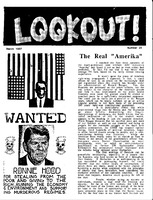 Lookout #25
Lookout #25 Lookout magazine started as a xeroxed community newsletter when Lawrence Livermore lived on Spy Rock, just a few miles north of Layonville, CA. Spy Rock was part of a constellation of locales across Mendocino and Humbdolt County that, since the late 1960s, had become increasingly popular among artists, hippies, and back-to-the-landers. Initially crafted in his solar-powered home, not far from the Iron Peak Lookout Tower, from which the magazine takes its name, the magazine engaged with local politics and tackled issues as diverse as environmental issues and countercultural philosophy. Over the years, following Livermore’s involvement with the Gilman Street Project in Berkeley and the punk-rock scene that loomed around it, Lookout’s focus shifted to music, which resulted in finding a whole new audience in the Bay Area and across the United States, especially among Maximum Rocknroll readers.
-
 Lookout #24 1/2
Lookout #24 1/2 Lookout magazine started as a xeroxed community newsletter when Lawrence Livermore lived on Spy Rock, just a few miles north of Layonville, CA. Spy Rock was part of a constellation of locales across Mendocino and Humbdolt County that, since the late 1960s, had become increasingly popular among artists, hippies, and back-to-the-landers. Initially crafted in his solar-powered home, not far from the Iron Peak Lookout Tower, from which the magazine takes its name, the magazine engaged with local politics and tackled issues as diverse as environmental issues and countercultural philosophy. Over the years, following Livermore’s involvement with the Gilman Street Project in Berkeley and the punk-rock scene that loomed around it, Lookout’s focus shifted to music, which resulted in finding a whole new audience in the Bay Area and across the United States, especially among Maximum Rocknroll readers.
-
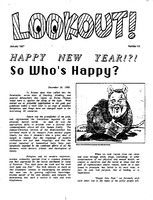 Lookout #24
Lookout #24 Lookout magazine started as a xeroxed community newsletter when Lawrence Livermore lived on Spy Rock, just a few miles north of Layonville, CA. Spy Rock was part of a constellation of locales across Mendocino and Humbdolt County that, since the late 1960s, had become increasingly popular among artists, hippies, and back-to-the-landers. Initially crafted in his solar-powered home, not far from the Iron Peak Lookout Tower, from which the magazine takes its name, the magazine engaged with local politics and tackled issues as diverse as environmental issues and countercultural philosophy. Over the years, following Livermore’s involvement with the Gilman Street Project in Berkeley and the punk-rock scene that loomed around it, Lookout’s focus shifted to music, which resulted in finding a whole new audience in the Bay Area and across the United States, especially among Maximum Rocknroll readers.
-
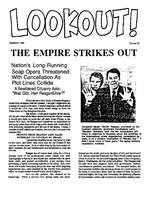 Lookout #23
Lookout #23 Lookout magazine started as a xeroxed community newsletter when Lawrence Livermore lived on Spy Rock, just a few miles north of Layonville, CA. Spy Rock was part of a constellation of locales across Mendocino and Humbdolt County that, since the late 1960s, had become increasingly popular among artists, hippies, and back-to-the-landers. Initially crafted in his solar-powered home, not far from the Iron Peak Lookout Tower, from which the magazine takes its name, the magazine engaged with local politics and tackled issues as diverse as environmental issues and countercultural philosophy. Over the years, following Livermore’s involvement with the Gilman Street Project in Berkeley and the punk-rock scene that loomed around it, Lookout’s focus shifted to music, which resulted in finding a whole new audience in the Bay Area and across the United States, especially among Maximum Rocknroll readers.
-
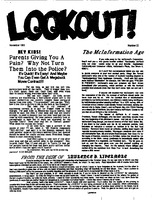 Lookout #22
Lookout #22 Lookout magazine started as a xeroxed community newsletter when Lawrence Livermore lived on Spy Rock, just a few miles north of Layonville, CA. Spy Rock was part of a constellation of locales across Mendocino and Humbdolt County that, since the late 1960s, had become increasingly popular among artists, hippies, and back-to-the-landers. Initially crafted in his solar-powered home, not far from the Iron Peak Lookout Tower, from which the magazine takes its name, the magazine engaged with local politics and tackled issues as diverse as environmental issues and countercultural philosophy. Over the years, following Livermore’s involvement with the Gilman Street Project in Berkeley and the punk-rock scene that loomed around it, Lookout’s focus shifted to music, which resulted in finding a whole new audience in the Bay Area and across the United States, especially among Maximum Rocknroll readers.
-
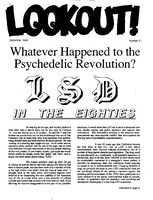 Lookout #21
Lookout #21 Lookout magazine started as a xeroxed community newsletter when Lawrence Livermore lived on Spy Rock, just a few miles north of Layonville, CA. Spy Rock was part of a constellation of locales across Mendocino and Humbdolt County that, since the late 1960s, had become increasingly popular among artists, hippies, and back-to-the-landers. Initially crafted in his solar-powered home, not far from the Iron Peak Lookout Tower, from which the magazine takes its name, the magazine engaged with local politics and tackled issues as diverse as environmental issues and countercultural philosophy. Over the years, following Livermore’s involvement with the Gilman Street Project in Berkeley and the punk-rock scene that loomed around it, Lookout’s focus shifted to music, which resulted in finding a whole new audience in the Bay Area and across the United States, especially among Maximum Rocknroll readers.
-
 Lookout #20
Lookout #20 Lookout magazine started as a xeroxed community newsletter when Lawrence Livermore lived on Spy Rock, just a few miles north of Layonville, CA. Spy Rock was part of a constellation of locales across Mendocino and Humbdolt County that, since the late 1960s, had become increasingly popular among artists, hippies, and back-to-the-landers. Initially crafted in his solar-powered home, not far from the Iron Peak Lookout Tower, from which the magazine takes its name, the magazine engaged with local politics and tackled issues as diverse as environmental issues and countercultural philosophy. Over the years, following Livermore’s involvement with the Gilman Street Project in Berkeley and the punk-rock scene that loomed around it, Lookout’s focus shifted to music, which resulted in finding a whole new audience in the Bay Area and across the United States, especially among Maximum Rocknroll readers.
-
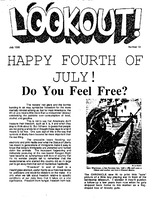 Lookout #19
Lookout #19 Lookout magazine started as a xeroxed community newsletter when Lawrence Livermore lived on Spy Rock, just a few miles north of Layonville, CA. Spy Rock was part of a constellation of locales across Mendocino and Humbdolt County that, since the late 1960s, had become increasingly popular among artists, hippies, and back-to-the-landers. Initially crafted in his solar-powered home, not far from the Iron Peak Lookout Tower, from which the magazine takes its name, the magazine engaged with local politics and tackled issues as diverse as environmental issues and countercultural philosophy. Over the years, following Livermore’s involvement with the Gilman Street Project in Berkeley and the punk-rock scene that loomed around it, Lookout’s focus shifted to music, which resulted in finding a whole new audience in the Bay Area and across the United States, especially among Maximum Rocknroll readers.
-
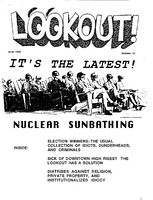 Lookout #18
Lookout #18 Lookout magazine started as a xeroxed community newsletter when Lawrence Livermore lived on Spy Rock, just a few miles north of Layonville, CA. Spy Rock was part of a constellation of locales across Mendocino and Humbdolt County that, since the late 1960s, had become increasingly popular among artists, hippies, and back-to-the-landers. Initially crafted in his solar-powered home, not far from the Iron Peak Lookout Tower, from which the magazine takes its name, the magazine engaged with local politics and tackled issues as diverse as environmental issues and countercultural philosophy. Over the years, following Livermore’s involvement with the Gilman Street Project in Berkeley and the punk-rock scene that loomed around it, Lookout’s focus shifted to music, which resulted in finding a whole new audience in the Bay Area and across the United States, especially among Maximum Rocknroll readers.
 Lookout #40 1/2 Lookout magazine started as a xeroxed community newsletter when Lawrence Livermore lived on Spy Rock, just a few miles north of Layonville, CA. Spy Rock was part of a constellation of locales across Mendocino and Humbdolt County that, since the late 1960s, had become increasingly popular among artists, hippies, and back-to-the-landers. Initially crafted in his solar-powered home, not far from the Iron Peak Lookout Tower, from which the magazine takes its name, the magazine engaged with local politics and tackled issues as diverse as environmental issues and countercultural philosophy. Over the years, following Livermore’s involvement with the Gilman Street Project in Berkeley and the punk-rock scene that loomed around it, Lookout’s focus shifted to music, which resulted in finding a whole new audience in the Bay Area and across the United States, especially among Maximum Rocknroll readers.
Lookout #40 1/2 Lookout magazine started as a xeroxed community newsletter when Lawrence Livermore lived on Spy Rock, just a few miles north of Layonville, CA. Spy Rock was part of a constellation of locales across Mendocino and Humbdolt County that, since the late 1960s, had become increasingly popular among artists, hippies, and back-to-the-landers. Initially crafted in his solar-powered home, not far from the Iron Peak Lookout Tower, from which the magazine takes its name, the magazine engaged with local politics and tackled issues as diverse as environmental issues and countercultural philosophy. Over the years, following Livermore’s involvement with the Gilman Street Project in Berkeley and the punk-rock scene that loomed around it, Lookout’s focus shifted to music, which resulted in finding a whole new audience in the Bay Area and across the United States, especially among Maximum Rocknroll readers. Lookout #40 Lookout magazine started as a xeroxed community newsletter when Lawrence Livermore lived on Spy Rock, just a few miles north of Layonville, CA. Spy Rock was part of a constellation of locales across Mendocino and Humbdolt County that, since the late 1960s, had become increasingly popular among artists, hippies, and back-to-the-landers. Initially crafted in his solar-powered home, not far from the Iron Peak Lookout Tower, from which the magazine takes its name, the magazine engaged with local politics and tackled issues as diverse as environmental issues and countercultural philosophy. Over the years, following Livermore’s involvement with the Gilman Street Project in Berkeley and the punk-rock scene that loomed around it, Lookout’s focus shifted to music, which resulted in finding a whole new audience in the Bay Area and across the United States, especially among Maximum Rocknroll readers.
Lookout #40 Lookout magazine started as a xeroxed community newsletter when Lawrence Livermore lived on Spy Rock, just a few miles north of Layonville, CA. Spy Rock was part of a constellation of locales across Mendocino and Humbdolt County that, since the late 1960s, had become increasingly popular among artists, hippies, and back-to-the-landers. Initially crafted in his solar-powered home, not far from the Iron Peak Lookout Tower, from which the magazine takes its name, the magazine engaged with local politics and tackled issues as diverse as environmental issues and countercultural philosophy. Over the years, following Livermore’s involvement with the Gilman Street Project in Berkeley and the punk-rock scene that loomed around it, Lookout’s focus shifted to music, which resulted in finding a whole new audience in the Bay Area and across the United States, especially among Maximum Rocknroll readers. Lookout #39 Lookout magazine started as a xeroxed community newsletter when Lawrence Livermore lived on Spy Rock, just a few miles north of Layonville, CA. Spy Rock was part of a constellation of locales across Mendocino and Humbdolt County that, since the late 1960s, had become increasingly popular among artists, hippies, and back-to-the-landers. Initially crafted in his solar-powered home, not far from the Iron Peak Lookout Tower, from which the magazine takes its name, the magazine engaged with local politics and tackled issues as diverse as environmental issues and countercultural philosophy. Over the years, following Livermore’s involvement with the Gilman Street Project in Berkeley and the punk-rock scene that loomed around it, Lookout’s focus shifted to music, which resulted in finding a whole new audience in the Bay Area and across the United States, especially among Maximum Rocknroll readers.
Lookout #39 Lookout magazine started as a xeroxed community newsletter when Lawrence Livermore lived on Spy Rock, just a few miles north of Layonville, CA. Spy Rock was part of a constellation of locales across Mendocino and Humbdolt County that, since the late 1960s, had become increasingly popular among artists, hippies, and back-to-the-landers. Initially crafted in his solar-powered home, not far from the Iron Peak Lookout Tower, from which the magazine takes its name, the magazine engaged with local politics and tackled issues as diverse as environmental issues and countercultural philosophy. Over the years, following Livermore’s involvement with the Gilman Street Project in Berkeley and the punk-rock scene that loomed around it, Lookout’s focus shifted to music, which resulted in finding a whole new audience in the Bay Area and across the United States, especially among Maximum Rocknroll readers. Lookout #38 Lookout magazine started as a xeroxed community newsletter when Lawrence Livermore lived on Spy Rock, just a few miles north of Layonville, CA. Spy Rock was part of a constellation of locales across Mendocino and Humbdolt County that, since the late 1960s, had become increasingly popular among artists, hippies, and back-to-the-landers. Initially crafted in his solar-powered home, not far from the Iron Peak Lookout Tower, from which the magazine takes its name, the magazine engaged with local politics and tackled issues as diverse as environmental issues and countercultural philosophy. Over the years, following Livermore’s involvement with the Gilman Street Project in Berkeley and the punk-rock scene that loomed around it, Lookout’s focus shifted to music, which resulted in finding a whole new audience in the Bay Area and across the United States, especially among Maximum Rocknroll readers.
Lookout #38 Lookout magazine started as a xeroxed community newsletter when Lawrence Livermore lived on Spy Rock, just a few miles north of Layonville, CA. Spy Rock was part of a constellation of locales across Mendocino and Humbdolt County that, since the late 1960s, had become increasingly popular among artists, hippies, and back-to-the-landers. Initially crafted in his solar-powered home, not far from the Iron Peak Lookout Tower, from which the magazine takes its name, the magazine engaged with local politics and tackled issues as diverse as environmental issues and countercultural philosophy. Over the years, following Livermore’s involvement with the Gilman Street Project in Berkeley and the punk-rock scene that loomed around it, Lookout’s focus shifted to music, which resulted in finding a whole new audience in the Bay Area and across the United States, especially among Maximum Rocknroll readers. Lookout #37 Lookout magazine started as a xeroxed community newsletter when Lawrence Livermore lived on Spy Rock, just a few miles north of Layonville, CA. Spy Rock was part of a constellation of locales across Mendocino and Humbdolt County that, since the late 1960s, had become increasingly popular among artists, hippies, and back-to-the-landers. Initially crafted in his solar-powered home, not far from the Iron Peak Lookout Tower, from which the magazine takes its name, the magazine engaged with local politics and tackled issues as diverse as environmental issues and countercultural philosophy. Over the years, following Livermore’s involvement with the Gilman Street Project in Berkeley and the punk-rock scene that loomed around it, Lookout’s focus shifted to music, which resulted in finding a whole new audience in the Bay Area and across the United States, especially among Maximum Rocknroll readers.
Lookout #37 Lookout magazine started as a xeroxed community newsletter when Lawrence Livermore lived on Spy Rock, just a few miles north of Layonville, CA. Spy Rock was part of a constellation of locales across Mendocino and Humbdolt County that, since the late 1960s, had become increasingly popular among artists, hippies, and back-to-the-landers. Initially crafted in his solar-powered home, not far from the Iron Peak Lookout Tower, from which the magazine takes its name, the magazine engaged with local politics and tackled issues as diverse as environmental issues and countercultural philosophy. Over the years, following Livermore’s involvement with the Gilman Street Project in Berkeley and the punk-rock scene that loomed around it, Lookout’s focus shifted to music, which resulted in finding a whole new audience in the Bay Area and across the United States, especially among Maximum Rocknroll readers. Lookout #36 Lookout magazine started as a xeroxed community newsletter when Lawrence Livermore lived on Spy Rock, just a few miles north of Layonville, CA. Spy Rock was part of a constellation of locales across Mendocino and Humbdolt County that, since the late 1960s, had become increasingly popular among artists, hippies, and back-to-the-landers. Initially crafted in his solar-powered home, not far from the Iron Peak Lookout Tower, from which the magazine takes its name, the magazine engaged with local politics and tackled issues as diverse as environmental issues and countercultural philosophy. Over the years, following Livermore’s involvement with the Gilman Street Project in Berkeley and the punk-rock scene that loomed around it, Lookout’s focus shifted to music, which resulted in finding a whole new audience in the Bay Area and across the United States, especially among Maximum Rocknroll readers.
Lookout #36 Lookout magazine started as a xeroxed community newsletter when Lawrence Livermore lived on Spy Rock, just a few miles north of Layonville, CA. Spy Rock was part of a constellation of locales across Mendocino and Humbdolt County that, since the late 1960s, had become increasingly popular among artists, hippies, and back-to-the-landers. Initially crafted in his solar-powered home, not far from the Iron Peak Lookout Tower, from which the magazine takes its name, the magazine engaged with local politics and tackled issues as diverse as environmental issues and countercultural philosophy. Over the years, following Livermore’s involvement with the Gilman Street Project in Berkeley and the punk-rock scene that loomed around it, Lookout’s focus shifted to music, which resulted in finding a whole new audience in the Bay Area and across the United States, especially among Maximum Rocknroll readers. Lookout #35 Lookout magazine started as a xeroxed community newsletter when Lawrence Livermore lived on Spy Rock, just a few miles north of Layonville, CA. Spy Rock was part of a constellation of locales across Mendocino and Humbdolt County that, since the late 1960s, had become increasingly popular among artists, hippies, and back-to-the-landers. Initially crafted in his solar-powered home, not far from the Iron Peak Lookout Tower, from which the magazine takes its name, the magazine engaged with local politics and tackled issues as diverse as environmental issues and countercultural philosophy. Over the years, following Livermore’s involvement with the Gilman Street Project in Berkeley and the punk-rock scene that loomed around it, Lookout’s focus shifted to music, which resulted in finding a whole new audience in the Bay Area and across the United States, especially among Maximum Rocknroll readers.
Lookout #35 Lookout magazine started as a xeroxed community newsletter when Lawrence Livermore lived on Spy Rock, just a few miles north of Layonville, CA. Spy Rock was part of a constellation of locales across Mendocino and Humbdolt County that, since the late 1960s, had become increasingly popular among artists, hippies, and back-to-the-landers. Initially crafted in his solar-powered home, not far from the Iron Peak Lookout Tower, from which the magazine takes its name, the magazine engaged with local politics and tackled issues as diverse as environmental issues and countercultural philosophy. Over the years, following Livermore’s involvement with the Gilman Street Project in Berkeley and the punk-rock scene that loomed around it, Lookout’s focus shifted to music, which resulted in finding a whole new audience in the Bay Area and across the United States, especially among Maximum Rocknroll readers. Lookout #34 Lookout magazine started as a xeroxed community newsletter when Lawrence Livermore lived on Spy Rock, just a few miles north of Layonville, CA. Spy Rock was part of a constellation of locales across Mendocino and Humbdolt County that, since the late 1960s, had become increasingly popular among artists, hippies, and back-to-the-landers. Initially crafted in his solar-powered home, not far from the Iron Peak Lookout Tower, from which the magazine takes its name, the magazine engaged with local politics and tackled issues as diverse as environmental issues and countercultural philosophy. Over the years, following Livermore’s involvement with the Gilman Street Project in Berkeley and the punk-rock scene that loomed around it, Lookout’s focus shifted to music, which resulted in finding a whole new audience in the Bay Area and across the United States, especially among Maximum Rocknroll readers.
Lookout #34 Lookout magazine started as a xeroxed community newsletter when Lawrence Livermore lived on Spy Rock, just a few miles north of Layonville, CA. Spy Rock was part of a constellation of locales across Mendocino and Humbdolt County that, since the late 1960s, had become increasingly popular among artists, hippies, and back-to-the-landers. Initially crafted in his solar-powered home, not far from the Iron Peak Lookout Tower, from which the magazine takes its name, the magazine engaged with local politics and tackled issues as diverse as environmental issues and countercultural philosophy. Over the years, following Livermore’s involvement with the Gilman Street Project in Berkeley and the punk-rock scene that loomed around it, Lookout’s focus shifted to music, which resulted in finding a whole new audience in the Bay Area and across the United States, especially among Maximum Rocknroll readers. Lookout #33 Lookout magazine started as a xeroxed community newsletter when Lawrence Livermore lived on Spy Rock, just a few miles north of Layonville, CA. Spy Rock was part of a constellation of locales across Mendocino and Humbdolt County that, since the late 1960s, had become increasingly popular among artists, hippies, and back-to-the-landers. Initially crafted in his solar-powered home, not far from the Iron Peak Lookout Tower, from which the magazine takes its name, the magazine engaged with local politics and tackled issues as diverse as environmental issues and countercultural philosophy. Over the years, following Livermore’s involvement with the Gilman Street Project in Berkeley and the punk-rock scene that loomed around it, Lookout’s focus shifted to music, which resulted in finding a whole new audience in the Bay Area and across the United States, especially among Maximum Rocknroll readers.
Lookout #33 Lookout magazine started as a xeroxed community newsletter when Lawrence Livermore lived on Spy Rock, just a few miles north of Layonville, CA. Spy Rock was part of a constellation of locales across Mendocino and Humbdolt County that, since the late 1960s, had become increasingly popular among artists, hippies, and back-to-the-landers. Initially crafted in his solar-powered home, not far from the Iron Peak Lookout Tower, from which the magazine takes its name, the magazine engaged with local politics and tackled issues as diverse as environmental issues and countercultural philosophy. Over the years, following Livermore’s involvement with the Gilman Street Project in Berkeley and the punk-rock scene that loomed around it, Lookout’s focus shifted to music, which resulted in finding a whole new audience in the Bay Area and across the United States, especially among Maximum Rocknroll readers. Lookout #32 Lookout magazine started as a xeroxed community newsletter when Lawrence Livermore lived on Spy Rock, just a few miles north of Layonville, CA. Spy Rock was part of a constellation of locales across Mendocino and Humbdolt County that, since the late 1960s, had become increasingly popular among artists, hippies, and back-to-the-landers. Initially crafted in his solar-powered home, not far from the Iron Peak Lookout Tower, from which the magazine takes its name, the magazine engaged with local politics and tackled issues as diverse as environmental issues and countercultural philosophy. Over the years, following Livermore’s involvement with the Gilman Street Project in Berkeley and the punk-rock scene that loomed around it, Lookout’s focus shifted to music, which resulted in finding a whole new audience in the Bay Area and across the United States, especially among Maximum Rocknroll readers.
Lookout #32 Lookout magazine started as a xeroxed community newsletter when Lawrence Livermore lived on Spy Rock, just a few miles north of Layonville, CA. Spy Rock was part of a constellation of locales across Mendocino and Humbdolt County that, since the late 1960s, had become increasingly popular among artists, hippies, and back-to-the-landers. Initially crafted in his solar-powered home, not far from the Iron Peak Lookout Tower, from which the magazine takes its name, the magazine engaged with local politics and tackled issues as diverse as environmental issues and countercultural philosophy. Over the years, following Livermore’s involvement with the Gilman Street Project in Berkeley and the punk-rock scene that loomed around it, Lookout’s focus shifted to music, which resulted in finding a whole new audience in the Bay Area and across the United States, especially among Maximum Rocknroll readers. Lookout #31 Lookout magazine started as a xeroxed community newsletter when Lawrence Livermore lived on Spy Rock, just a few miles north of Layonville, CA. Spy Rock was part of a constellation of locales across Mendocino and Humbdolt County that, since the late 1960s, had become increasingly popular among artists, hippies, and back-to-the-landers. Initially crafted in his solar-powered home, not far from the Iron Peak Lookout Tower, from which the magazine takes its name, the magazine engaged with local politics and tackled issues as diverse as environmental issues and countercultural philosophy. Over the years, following Livermore’s involvement with the Gilman Street Project in Berkeley and the punk-rock scene that loomed around it, Lookout’s focus shifted to music, which resulted in finding a whole new audience in the Bay Area and across the United States, especially among Maximum Rocknroll readers.
Lookout #31 Lookout magazine started as a xeroxed community newsletter when Lawrence Livermore lived on Spy Rock, just a few miles north of Layonville, CA. Spy Rock was part of a constellation of locales across Mendocino and Humbdolt County that, since the late 1960s, had become increasingly popular among artists, hippies, and back-to-the-landers. Initially crafted in his solar-powered home, not far from the Iron Peak Lookout Tower, from which the magazine takes its name, the magazine engaged with local politics and tackled issues as diverse as environmental issues and countercultural philosophy. Over the years, following Livermore’s involvement with the Gilman Street Project in Berkeley and the punk-rock scene that loomed around it, Lookout’s focus shifted to music, which resulted in finding a whole new audience in the Bay Area and across the United States, especially among Maximum Rocknroll readers. Lookout #30 Lookout magazine started as a xeroxed community newsletter when Lawrence Livermore lived on Spy Rock, just a few miles north of Layonville, CA. Spy Rock was part of a constellation of locales across Mendocino and Humbdolt County that, since the late 1960s, had become increasingly popular among artists, hippies, and back-to-the-landers. Initially crafted in his solar-powered home, not far from the Iron Peak Lookout Tower, from which the magazine takes its name, the magazine engaged with local politics and tackled issues as diverse as environmental issues and countercultural philosophy. Over the years, following Livermore’s involvement with the Gilman Street Project in Berkeley and the punk-rock scene that loomed around it, Lookout’s focus shifted to music, which resulted in finding a whole new audience in the Bay Area and across the United States, especially among Maximum Rocknroll readers.
Lookout #30 Lookout magazine started as a xeroxed community newsletter when Lawrence Livermore lived on Spy Rock, just a few miles north of Layonville, CA. Spy Rock was part of a constellation of locales across Mendocino and Humbdolt County that, since the late 1960s, had become increasingly popular among artists, hippies, and back-to-the-landers. Initially crafted in his solar-powered home, not far from the Iron Peak Lookout Tower, from which the magazine takes its name, the magazine engaged with local politics and tackled issues as diverse as environmental issues and countercultural philosophy. Over the years, following Livermore’s involvement with the Gilman Street Project in Berkeley and the punk-rock scene that loomed around it, Lookout’s focus shifted to music, which resulted in finding a whole new audience in the Bay Area and across the United States, especially among Maximum Rocknroll readers. Lookout #29 Lookout magazine started as a xeroxed community newsletter when Lawrence Livermore lived on Spy Rock, just a few miles north of Layonville, CA. Spy Rock was part of a constellation of locales across Mendocino and Humbdolt County that, since the late 1960s, had become increasingly popular among artists, hippies, and back-to-the-landers. Initially crafted in his solar-powered home, not far from the Iron Peak Lookout Tower, from which the magazine takes its name, the magazine engaged with local politics and tackled issues as diverse as environmental issues and countercultural philosophy. Over the years, following Livermore’s involvement with the Gilman Street Project in Berkeley and the punk-rock scene that loomed around it, Lookout’s focus shifted to music, which resulted in finding a whole new audience in the Bay Area and across the United States, especially among Maximum Rocknroll readers.
Lookout #29 Lookout magazine started as a xeroxed community newsletter when Lawrence Livermore lived on Spy Rock, just a few miles north of Layonville, CA. Spy Rock was part of a constellation of locales across Mendocino and Humbdolt County that, since the late 1960s, had become increasingly popular among artists, hippies, and back-to-the-landers. Initially crafted in his solar-powered home, not far from the Iron Peak Lookout Tower, from which the magazine takes its name, the magazine engaged with local politics and tackled issues as diverse as environmental issues and countercultural philosophy. Over the years, following Livermore’s involvement with the Gilman Street Project in Berkeley and the punk-rock scene that loomed around it, Lookout’s focus shifted to music, which resulted in finding a whole new audience in the Bay Area and across the United States, especially among Maximum Rocknroll readers. Lookout #28 Lookout magazine started as a xeroxed community newsletter when Lawrence Livermore lived on Spy Rock, just a few miles north of Layonville, CA. Spy Rock was part of a constellation of locales across Mendocino and Humbdolt County that, since the late 1960s, had become increasingly popular among artists, hippies, and back-to-the-landers. Initially crafted in his solar-powered home, not far from the Iron Peak Lookout Tower, from which the magazine takes its name, the magazine engaged with local politics and tackled issues as diverse as environmental issues and countercultural philosophy. Over the years, following Livermore’s involvement with the Gilman Street Project in Berkeley and the punk-rock scene that loomed around it, Lookout’s focus shifted to music, which resulted in finding a whole new audience in the Bay Area and across the United States, especially among Maximum Rocknroll readers.
Lookout #28 Lookout magazine started as a xeroxed community newsletter when Lawrence Livermore lived on Spy Rock, just a few miles north of Layonville, CA. Spy Rock was part of a constellation of locales across Mendocino and Humbdolt County that, since the late 1960s, had become increasingly popular among artists, hippies, and back-to-the-landers. Initially crafted in his solar-powered home, not far from the Iron Peak Lookout Tower, from which the magazine takes its name, the magazine engaged with local politics and tackled issues as diverse as environmental issues and countercultural philosophy. Over the years, following Livermore’s involvement with the Gilman Street Project in Berkeley and the punk-rock scene that loomed around it, Lookout’s focus shifted to music, which resulted in finding a whole new audience in the Bay Area and across the United States, especially among Maximum Rocknroll readers. Lookout #27 Lookout magazine started as a xeroxed community newsletter when Lawrence Livermore lived on Spy Rock, just a few miles north of Layonville, CA. Spy Rock was part of a constellation of locales across Mendocino and Humbdolt County that, since the late 1960s, had become increasingly popular among artists, hippies, and back-to-the-landers. Initially crafted in his solar-powered home, not far from the Iron Peak Lookout Tower, from which the magazine takes its name, the magazine engaged with local politics and tackled issues as diverse as environmental issues and countercultural philosophy. Over the years, following Livermore’s involvement with the Gilman Street Project in Berkeley and the punk-rock scene that loomed around it, Lookout’s focus shifted to music, which resulted in finding a whole new audience in the Bay Area and across the United States, especially among Maximum Rocknroll readers.
Lookout #27 Lookout magazine started as a xeroxed community newsletter when Lawrence Livermore lived on Spy Rock, just a few miles north of Layonville, CA. Spy Rock was part of a constellation of locales across Mendocino and Humbdolt County that, since the late 1960s, had become increasingly popular among artists, hippies, and back-to-the-landers. Initially crafted in his solar-powered home, not far from the Iron Peak Lookout Tower, from which the magazine takes its name, the magazine engaged with local politics and tackled issues as diverse as environmental issues and countercultural philosophy. Over the years, following Livermore’s involvement with the Gilman Street Project in Berkeley and the punk-rock scene that loomed around it, Lookout’s focus shifted to music, which resulted in finding a whole new audience in the Bay Area and across the United States, especially among Maximum Rocknroll readers. Lookout #26 Lookout magazine started as a xeroxed community newsletter when Lawrence Livermore lived on Spy Rock, just a few miles north of Layonville, CA. Spy Rock was part of a constellation of locales across Mendocino and Humbdolt County that, since the late 1960s, had become increasingly popular among artists, hippies, and back-to-the-landers. Initially crafted in his solar-powered home, not far from the Iron Peak Lookout Tower, from which the magazine takes its name, the magazine engaged with local politics and tackled issues as diverse as environmental issues and countercultural philosophy. Over the years, following Livermore’s involvement with the Gilman Street Project in Berkeley and the punk-rock scene that loomed around it, Lookout’s focus shifted to music, which resulted in finding a whole new audience in the Bay Area and across the United States, especially among Maximum Rocknroll readers.
Lookout #26 Lookout magazine started as a xeroxed community newsletter when Lawrence Livermore lived on Spy Rock, just a few miles north of Layonville, CA. Spy Rock was part of a constellation of locales across Mendocino and Humbdolt County that, since the late 1960s, had become increasingly popular among artists, hippies, and back-to-the-landers. Initially crafted in his solar-powered home, not far from the Iron Peak Lookout Tower, from which the magazine takes its name, the magazine engaged with local politics and tackled issues as diverse as environmental issues and countercultural philosophy. Over the years, following Livermore’s involvement with the Gilman Street Project in Berkeley and the punk-rock scene that loomed around it, Lookout’s focus shifted to music, which resulted in finding a whole new audience in the Bay Area and across the United States, especially among Maximum Rocknroll readers. Lookout #25 Lookout magazine started as a xeroxed community newsletter when Lawrence Livermore lived on Spy Rock, just a few miles north of Layonville, CA. Spy Rock was part of a constellation of locales across Mendocino and Humbdolt County that, since the late 1960s, had become increasingly popular among artists, hippies, and back-to-the-landers. Initially crafted in his solar-powered home, not far from the Iron Peak Lookout Tower, from which the magazine takes its name, the magazine engaged with local politics and tackled issues as diverse as environmental issues and countercultural philosophy. Over the years, following Livermore’s involvement with the Gilman Street Project in Berkeley and the punk-rock scene that loomed around it, Lookout’s focus shifted to music, which resulted in finding a whole new audience in the Bay Area and across the United States, especially among Maximum Rocknroll readers.
Lookout #25 Lookout magazine started as a xeroxed community newsletter when Lawrence Livermore lived on Spy Rock, just a few miles north of Layonville, CA. Spy Rock was part of a constellation of locales across Mendocino and Humbdolt County that, since the late 1960s, had become increasingly popular among artists, hippies, and back-to-the-landers. Initially crafted in his solar-powered home, not far from the Iron Peak Lookout Tower, from which the magazine takes its name, the magazine engaged with local politics and tackled issues as diverse as environmental issues and countercultural philosophy. Over the years, following Livermore’s involvement with the Gilman Street Project in Berkeley and the punk-rock scene that loomed around it, Lookout’s focus shifted to music, which resulted in finding a whole new audience in the Bay Area and across the United States, especially among Maximum Rocknroll readers. Lookout #24 1/2 Lookout magazine started as a xeroxed community newsletter when Lawrence Livermore lived on Spy Rock, just a few miles north of Layonville, CA. Spy Rock was part of a constellation of locales across Mendocino and Humbdolt County that, since the late 1960s, had become increasingly popular among artists, hippies, and back-to-the-landers. Initially crafted in his solar-powered home, not far from the Iron Peak Lookout Tower, from which the magazine takes its name, the magazine engaged with local politics and tackled issues as diverse as environmental issues and countercultural philosophy. Over the years, following Livermore’s involvement with the Gilman Street Project in Berkeley and the punk-rock scene that loomed around it, Lookout’s focus shifted to music, which resulted in finding a whole new audience in the Bay Area and across the United States, especially among Maximum Rocknroll readers.
Lookout #24 1/2 Lookout magazine started as a xeroxed community newsletter when Lawrence Livermore lived on Spy Rock, just a few miles north of Layonville, CA. Spy Rock was part of a constellation of locales across Mendocino and Humbdolt County that, since the late 1960s, had become increasingly popular among artists, hippies, and back-to-the-landers. Initially crafted in his solar-powered home, not far from the Iron Peak Lookout Tower, from which the magazine takes its name, the magazine engaged with local politics and tackled issues as diverse as environmental issues and countercultural philosophy. Over the years, following Livermore’s involvement with the Gilman Street Project in Berkeley and the punk-rock scene that loomed around it, Lookout’s focus shifted to music, which resulted in finding a whole new audience in the Bay Area and across the United States, especially among Maximum Rocknroll readers. Lookout #24 Lookout magazine started as a xeroxed community newsletter when Lawrence Livermore lived on Spy Rock, just a few miles north of Layonville, CA. Spy Rock was part of a constellation of locales across Mendocino and Humbdolt County that, since the late 1960s, had become increasingly popular among artists, hippies, and back-to-the-landers. Initially crafted in his solar-powered home, not far from the Iron Peak Lookout Tower, from which the magazine takes its name, the magazine engaged with local politics and tackled issues as diverse as environmental issues and countercultural philosophy. Over the years, following Livermore’s involvement with the Gilman Street Project in Berkeley and the punk-rock scene that loomed around it, Lookout’s focus shifted to music, which resulted in finding a whole new audience in the Bay Area and across the United States, especially among Maximum Rocknroll readers.
Lookout #24 Lookout magazine started as a xeroxed community newsletter when Lawrence Livermore lived on Spy Rock, just a few miles north of Layonville, CA. Spy Rock was part of a constellation of locales across Mendocino and Humbdolt County that, since the late 1960s, had become increasingly popular among artists, hippies, and back-to-the-landers. Initially crafted in his solar-powered home, not far from the Iron Peak Lookout Tower, from which the magazine takes its name, the magazine engaged with local politics and tackled issues as diverse as environmental issues and countercultural philosophy. Over the years, following Livermore’s involvement with the Gilman Street Project in Berkeley and the punk-rock scene that loomed around it, Lookout’s focus shifted to music, which resulted in finding a whole new audience in the Bay Area and across the United States, especially among Maximum Rocknroll readers. Lookout #23 Lookout magazine started as a xeroxed community newsletter when Lawrence Livermore lived on Spy Rock, just a few miles north of Layonville, CA. Spy Rock was part of a constellation of locales across Mendocino and Humbdolt County that, since the late 1960s, had become increasingly popular among artists, hippies, and back-to-the-landers. Initially crafted in his solar-powered home, not far from the Iron Peak Lookout Tower, from which the magazine takes its name, the magazine engaged with local politics and tackled issues as diverse as environmental issues and countercultural philosophy. Over the years, following Livermore’s involvement with the Gilman Street Project in Berkeley and the punk-rock scene that loomed around it, Lookout’s focus shifted to music, which resulted in finding a whole new audience in the Bay Area and across the United States, especially among Maximum Rocknroll readers.
Lookout #23 Lookout magazine started as a xeroxed community newsletter when Lawrence Livermore lived on Spy Rock, just a few miles north of Layonville, CA. Spy Rock was part of a constellation of locales across Mendocino and Humbdolt County that, since the late 1960s, had become increasingly popular among artists, hippies, and back-to-the-landers. Initially crafted in his solar-powered home, not far from the Iron Peak Lookout Tower, from which the magazine takes its name, the magazine engaged with local politics and tackled issues as diverse as environmental issues and countercultural philosophy. Over the years, following Livermore’s involvement with the Gilman Street Project in Berkeley and the punk-rock scene that loomed around it, Lookout’s focus shifted to music, which resulted in finding a whole new audience in the Bay Area and across the United States, especially among Maximum Rocknroll readers. Lookout #22 Lookout magazine started as a xeroxed community newsletter when Lawrence Livermore lived on Spy Rock, just a few miles north of Layonville, CA. Spy Rock was part of a constellation of locales across Mendocino and Humbdolt County that, since the late 1960s, had become increasingly popular among artists, hippies, and back-to-the-landers. Initially crafted in his solar-powered home, not far from the Iron Peak Lookout Tower, from which the magazine takes its name, the magazine engaged with local politics and tackled issues as diverse as environmental issues and countercultural philosophy. Over the years, following Livermore’s involvement with the Gilman Street Project in Berkeley and the punk-rock scene that loomed around it, Lookout’s focus shifted to music, which resulted in finding a whole new audience in the Bay Area and across the United States, especially among Maximum Rocknroll readers.
Lookout #22 Lookout magazine started as a xeroxed community newsletter when Lawrence Livermore lived on Spy Rock, just a few miles north of Layonville, CA. Spy Rock was part of a constellation of locales across Mendocino and Humbdolt County that, since the late 1960s, had become increasingly popular among artists, hippies, and back-to-the-landers. Initially crafted in his solar-powered home, not far from the Iron Peak Lookout Tower, from which the magazine takes its name, the magazine engaged with local politics and tackled issues as diverse as environmental issues and countercultural philosophy. Over the years, following Livermore’s involvement with the Gilman Street Project in Berkeley and the punk-rock scene that loomed around it, Lookout’s focus shifted to music, which resulted in finding a whole new audience in the Bay Area and across the United States, especially among Maximum Rocknroll readers. Lookout #21 Lookout magazine started as a xeroxed community newsletter when Lawrence Livermore lived on Spy Rock, just a few miles north of Layonville, CA. Spy Rock was part of a constellation of locales across Mendocino and Humbdolt County that, since the late 1960s, had become increasingly popular among artists, hippies, and back-to-the-landers. Initially crafted in his solar-powered home, not far from the Iron Peak Lookout Tower, from which the magazine takes its name, the magazine engaged with local politics and tackled issues as diverse as environmental issues and countercultural philosophy. Over the years, following Livermore’s involvement with the Gilman Street Project in Berkeley and the punk-rock scene that loomed around it, Lookout’s focus shifted to music, which resulted in finding a whole new audience in the Bay Area and across the United States, especially among Maximum Rocknroll readers.
Lookout #21 Lookout magazine started as a xeroxed community newsletter when Lawrence Livermore lived on Spy Rock, just a few miles north of Layonville, CA. Spy Rock was part of a constellation of locales across Mendocino and Humbdolt County that, since the late 1960s, had become increasingly popular among artists, hippies, and back-to-the-landers. Initially crafted in his solar-powered home, not far from the Iron Peak Lookout Tower, from which the magazine takes its name, the magazine engaged with local politics and tackled issues as diverse as environmental issues and countercultural philosophy. Over the years, following Livermore’s involvement with the Gilman Street Project in Berkeley and the punk-rock scene that loomed around it, Lookout’s focus shifted to music, which resulted in finding a whole new audience in the Bay Area and across the United States, especially among Maximum Rocknroll readers. Lookout #20 Lookout magazine started as a xeroxed community newsletter when Lawrence Livermore lived on Spy Rock, just a few miles north of Layonville, CA. Spy Rock was part of a constellation of locales across Mendocino and Humbdolt County that, since the late 1960s, had become increasingly popular among artists, hippies, and back-to-the-landers. Initially crafted in his solar-powered home, not far from the Iron Peak Lookout Tower, from which the magazine takes its name, the magazine engaged with local politics and tackled issues as diverse as environmental issues and countercultural philosophy. Over the years, following Livermore’s involvement with the Gilman Street Project in Berkeley and the punk-rock scene that loomed around it, Lookout’s focus shifted to music, which resulted in finding a whole new audience in the Bay Area and across the United States, especially among Maximum Rocknroll readers.
Lookout #20 Lookout magazine started as a xeroxed community newsletter when Lawrence Livermore lived on Spy Rock, just a few miles north of Layonville, CA. Spy Rock was part of a constellation of locales across Mendocino and Humbdolt County that, since the late 1960s, had become increasingly popular among artists, hippies, and back-to-the-landers. Initially crafted in his solar-powered home, not far from the Iron Peak Lookout Tower, from which the magazine takes its name, the magazine engaged with local politics and tackled issues as diverse as environmental issues and countercultural philosophy. Over the years, following Livermore’s involvement with the Gilman Street Project in Berkeley and the punk-rock scene that loomed around it, Lookout’s focus shifted to music, which resulted in finding a whole new audience in the Bay Area and across the United States, especially among Maximum Rocknroll readers. Lookout #19 Lookout magazine started as a xeroxed community newsletter when Lawrence Livermore lived on Spy Rock, just a few miles north of Layonville, CA. Spy Rock was part of a constellation of locales across Mendocino and Humbdolt County that, since the late 1960s, had become increasingly popular among artists, hippies, and back-to-the-landers. Initially crafted in his solar-powered home, not far from the Iron Peak Lookout Tower, from which the magazine takes its name, the magazine engaged with local politics and tackled issues as diverse as environmental issues and countercultural philosophy. Over the years, following Livermore’s involvement with the Gilman Street Project in Berkeley and the punk-rock scene that loomed around it, Lookout’s focus shifted to music, which resulted in finding a whole new audience in the Bay Area and across the United States, especially among Maximum Rocknroll readers.
Lookout #19 Lookout magazine started as a xeroxed community newsletter when Lawrence Livermore lived on Spy Rock, just a few miles north of Layonville, CA. Spy Rock was part of a constellation of locales across Mendocino and Humbdolt County that, since the late 1960s, had become increasingly popular among artists, hippies, and back-to-the-landers. Initially crafted in his solar-powered home, not far from the Iron Peak Lookout Tower, from which the magazine takes its name, the magazine engaged with local politics and tackled issues as diverse as environmental issues and countercultural philosophy. Over the years, following Livermore’s involvement with the Gilman Street Project in Berkeley and the punk-rock scene that loomed around it, Lookout’s focus shifted to music, which resulted in finding a whole new audience in the Bay Area and across the United States, especially among Maximum Rocknroll readers. Lookout #18 Lookout magazine started as a xeroxed community newsletter when Lawrence Livermore lived on Spy Rock, just a few miles north of Layonville, CA. Spy Rock was part of a constellation of locales across Mendocino and Humbdolt County that, since the late 1960s, had become increasingly popular among artists, hippies, and back-to-the-landers. Initially crafted in his solar-powered home, not far from the Iron Peak Lookout Tower, from which the magazine takes its name, the magazine engaged with local politics and tackled issues as diverse as environmental issues and countercultural philosophy. Over the years, following Livermore’s involvement with the Gilman Street Project in Berkeley and the punk-rock scene that loomed around it, Lookout’s focus shifted to music, which resulted in finding a whole new audience in the Bay Area and across the United States, especially among Maximum Rocknroll readers.
Lookout #18 Lookout magazine started as a xeroxed community newsletter when Lawrence Livermore lived on Spy Rock, just a few miles north of Layonville, CA. Spy Rock was part of a constellation of locales across Mendocino and Humbdolt County that, since the late 1960s, had become increasingly popular among artists, hippies, and back-to-the-landers. Initially crafted in his solar-powered home, not far from the Iron Peak Lookout Tower, from which the magazine takes its name, the magazine engaged with local politics and tackled issues as diverse as environmental issues and countercultural philosophy. Over the years, following Livermore’s involvement with the Gilman Street Project in Berkeley and the punk-rock scene that loomed around it, Lookout’s focus shifted to music, which resulted in finding a whole new audience in the Bay Area and across the United States, especially among Maximum Rocknroll readers.
